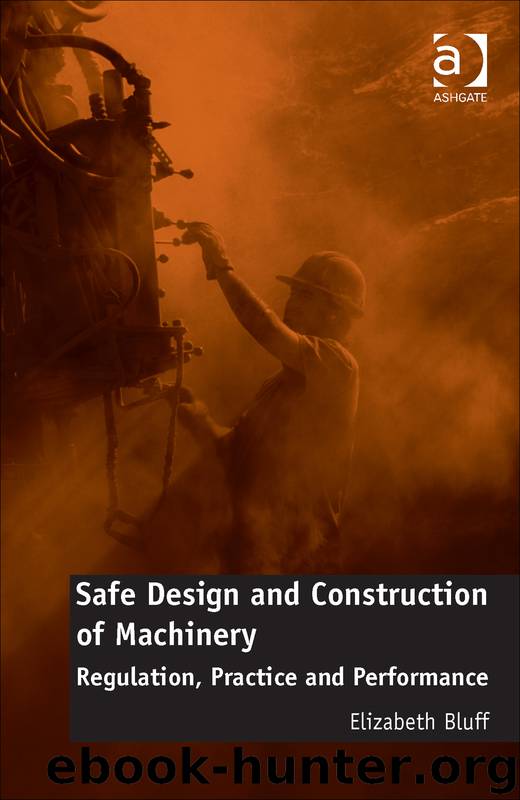Safe Design and Construction of Machinery by Elizabeth Bluff

Author:Elizabeth Bluff
Language: eng
Format: epub
Publisher: Ashgate Publishing Limited
Published: 2015-03-14T16:00:00+00:00
Risk Assessment and Risk Management Concepts
Technical approaches to risk management conceptually distinguish hazards, risks, assessment of risks and risk control measures (Cross, et al., 2000; Frick, 2006; and see CEN, 2010; NOHSC, 1994). Hazards are typically defined as the potential to cause harm (death, injury or illness), and risk as the combination of the probability (or likelihood) of the occurrence of harm and the severity of that harm (consequences). Assessment of risk therefore involves consideration of the severity of harm and the probability of their occurrence, but may be further broken down into a risk analysis phase involving hazard identification and risk estimation, and risk evaluation to determine measures needed to reduce the risk. Risk controls are the measures used to eliminate or minimize risks, ranging from design changes, engineering controls and safeguards, to warning signs or devices, safe work practices, and personal protective equipment (see Chapter 3).
Based on the accounts of the key individuals in the 66 study firms, only some were familiar with hazard, risk and risk assessment concepts. The key individuals in some firms did not use the term hazard (41 per cent (27/66)), and/or the term risk (26 per cent (17/66)). Also, these and some other firms did not conduct, or engage a consultant to conduct, any process which they called risk assessment or risks analysis (41 per cent (27/66)). When they did, their key individuals tended to use the terms assessment and analysis interchangeably, rather than seeing risk analysis as a phase within a broader process of risk assessment (as outlined above). It appeared that, in constructing knowledge about machinery safety matters through practice (see Chapter 6), key individuals had not worked in, or had experience of, situations through which they became familiar with hazard, risk and assessment concepts.
The absence of the terms hazard and risk from the discourse of some key individuals was more evident in firms that did not conduct any form of risk assessment but the key individuals in most firms used more everyday language. They talked about safety issues or safety problems (62 per cent (41/66)), and safety aspects or safety things (45 per cent (30/66)). Rather than discussing risk control measures, they referred to safety features, safety measures or safety devices (29 per cent (19/66)), or simply named particular types of measures such as guarding, covers, rails or safety switches.
The use of more everyday expressions by the key individuals in some firms was not just a matter of terminology. It reflected the conflation of concepts of hazard, risk and control measures in practice. As other research has found, individuals conducting assessments may lack the analytical abilities to separate cause and effect, and understand the principles of prevention (Jensen, 2001). In the present research there was a tendency to merge consideration of sources of harm with control measures in a see it/fix it approach. If a firm recognized the potential for someone to get hurt, they implemented preventive measures without considering, in a more differentiated way, the hazard, risk and possible risk control measures.
Download
This site does not store any files on its server. We only index and link to content provided by other sites. Please contact the content providers to delete copyright contents if any and email us, we'll remove relevant links or contents immediately.
International Integration of the Brazilian Economy by Elias C. Grivoyannis(98311)
The Radium Girls by Kate Moore(11967)
Turbulence by E. J. Noyes(7977)
Nudge - Improving Decisions about Health, Wealth, and Happiness by Thaler Sunstein(7654)
The Black Swan by Nassim Nicholas Taleb(7054)
Rich Dad Poor Dad by Robert T. Kiyosaki(6503)
Pioneering Portfolio Management by David F. Swensen(6253)
Man-made Catastrophes and Risk Information Concealment by Dmitry Chernov & Didier Sornette(5951)
Zero to One by Peter Thiel(5728)
Secrecy World by Jake Bernstein(4698)
Millionaire: The Philanderer, Gambler, and Duelist Who Invented Modern Finance by Janet Gleeson(4417)
The Age of Surveillance Capitalism by Shoshana Zuboff(4241)
Skin in the Game by Nassim Nicholas Taleb(4200)
Bullshit Jobs by David Graeber(4136)
The Money Culture by Michael Lewis(4127)
Skin in the Game: Hidden Asymmetries in Daily Life by Nassim Nicholas Taleb(3960)
The Dhandho Investor by Mohnish Pabrai(3721)
The Wisdom of Finance by Mihir Desai(3691)
Blockchain Basics by Daniel Drescher(3533)
